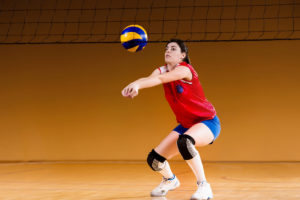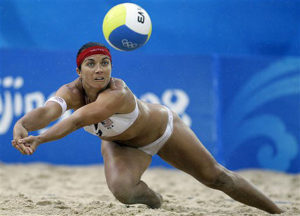As with the majority of sports, volleyball requires all players to gain some basic skills before they are able to excel at the sport. This article will provide the top six key volleyball fundamentals or core skills a person needs to become a competent volleyball player, and then potentially move onto expert status.
1. Passing The Ball

In its most simplistic form, passing the ball in a volleyball game is giving the ball to another player on your team after it has been hit over the net – also known as serving. This is considered the most significant fundamental in volleyball because a team cannot return the ball without a solid pass. While some people think passing the ball is a simple task, it is not and can be challenging for the novice player. This is because there are different types of passes, such as forearm passes and overhead passes, which need to be learned before one can play a competent game.
2. Spiking

One of the crowd-pleasing aspects of any volleyball game is spiking. A player spikes the ball when they slam the ball down across the volleyball net to the opposing team’s side of the volleyball court. Spiking is a difficult technique to learn and execute, but if performed correctly it can be beneficial as it is challenging to return. A good spike can easily accumulate points and can help a team win.
3. Digging

Now that we have covered the offensive fundamentals, we can look at the defensive fundamentals. Digging is one of the most significant defensive techniques in volleyball and it can save a team from spikes or attacks. Digging is typically used to defend a spike and the player will need to dive over the ball and pass it to a player in their team using a single fluid motion. Unlike typical passes, they will need to recover the ball as it heads in a downward trajectory. This is an ideal skill to have as it can stop an opposing team from accumulating points.
4. Blocking

Despite being one of the more expendable of the core skills, blocking can be a highly beneficial fundamental to any player’s artillery. Blocking involves jumping up and deflecting an opposing player’s pass before it crosses the volleyball net. This often takes the player by surprise and can provide your team with a point depending on how far across the net you reach. Blocking can add a good dimension to the volleyball game and will keep teams ‘on their toes’.
5. Serving

The most important fundamental is the initial movement of serving. How can a volleyball player use their skills if the ball is not served to begin the game? Serving, as with passing, is considered a simple task but it is complicated due to the different types of serves. The most commonly used serves include the overhand and underhand serves.
An overhand serve is a more advanced option involving tossing the ball up while pulling the dominant arm backwards, then swing. Do not follow through with the full serving movement before the hand connects with the ball, so you should feel as if you are punching the ball over the net.
The underhand serve is simpler and used in the majority of volleyball games. Holding the ball in your less dominant hand (if right-handed, this will be the left hand), make a fist with the other hand and connect with the underside of the ball to hit it over the volleyball net.
6. Setting

Setting is not a skill used by all players on a team, but a single position; however, all players should learn this fundamental as it is the most important position. The function of a setter is to make it easier for their teammates to hit the ball over the net, preferably using a spike. Setting involves getting the ball in the air ready to be spike by another player.
